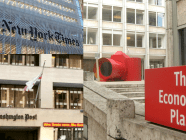Tagesspiegel, February 15, 2009
Rapidly declining advertising, downsized editorial departments, readers scampering to the Internet – the U.S. press is trapped in a downward spiral.
Two years ago David Carr, a prominent media journalist for the New York Times, speculated about how future historians might evaluate today’s world. Carr’s hunch? “There is a chance that historians will examine this period in American history and wonder if journalism left the field.” Michael Hirchorn recently responded to Carr in the Atlantic Monthly, stating that even an iconic newspaper like the Times might wind up broke in the next year.
Indeed, if there’s an American industry in worse shape than the banking industry, it’s the daily papers. Not long ago, casinos were the one and only business in which more money could be made. Since then, however, not only is the newspaper industry’s existence in America endangered, but respectable journalism also teeters to disappear in a Bermuda Triangle. The metaphor works nicely as newspapers, as well as their editorial departments, are under pressure from three different angles.
First, readers drift to the Internet in droves. This is no surprise, as Internet news arrives rapidly and free of charge. Granted, for many years publishing houses knew such changes in reading habits would arise. Information was made available online at no charge, as publishers fostered the hope that advertising income would move to the Internet along with readers. If the public would read news online rather than rustle papers at the breakfast table, publishers could simply eliminate their greatest block of costs: paper, print and distribution.
Until recently, online news maintained solid growth: rates: In 2008, the Top Ten of the newspaper Websites had 40 million more visitors than the previous year, an increase of 16 percent. However, the latest report on the condition of U.S. media by the Project for Excellence in Journalism depicts a rather dismal future: “But more and more it appears the biggest problem facing traditional media has less to do with where people get information than how to pay for it — the emerging reality that advertising isn’t migrating online with the consumer. The crisis in journalism, in other words, may not strictly be loss of audience. It may, more fundamentally, be the decoupling of news and advertising.”
Secondly, advertising managers of miscalculated two crucial areas. In “the good old days,” most papers had regional or local oligopolies or monopolies – a dominating market position. Therefore they benefit from strong advertising rates and dream returns for decades. On the Internet, however, competition prevails. The competitor, who seeks the same advertiser, is only a mouse click away. Therefore the advertising revenue margins that once generously financed the editorial departments have shrunk. Gone are the days when not only publishers but also editors and reporters were able to live in the lap of luxury.
Conditions are close to paradise for advertisers for another reason: Today, they can reach target groups with little wasted coverage. A far cry from the concerns of Henry Ford, who worried that half of his advertising budget was thrown out the window though he didn’t know which half. Today, Google and other search engines pocket the majority of the advertising income that newspaper publishing houses had hoped to get.
Newspaper managers also missed this development: Anyone looking for a new girlfriend or car can advertise online for free, provided he or she is not running a business. Classified advertisements, which until a few years ago held 40 percent of U.S. publisher’s advertising income, are rapidly declining. Although newspaper classifieds still bring approximately $14 billion annually, this is a third less than the all-time high achieved in 2000.
In the discussion of the future of newspapers, little attention is given to the third corner of the Bermuda triangle, the impact of Public Relations – although it shouldn’t be dismissed. In past years, hardly any other industry was growing as much as the PR industry. An armada of over 243,000 PR people face approximately 100,000 journalists today. The Bureau of Labor Statistics predicts an 18 percent increase in PR professionals in the next 10 years, while the editorial departments will probably continue to shrink at cyberspeed.
Years ago, Berlin-based communication researcher Barbara Baerns observed a trend that is now gaining speed. Gateways in newsrooms for PR work are opening up wider and wider, and more and more frequently, editorial departments convert press releases into “journalism.” This can be done with a single mouse click and no prior fact-checking. As a result, intelligent readers begin to doubt the reliability of their media and don’t wish to pay for it. Those in charge of businesses, in politics, administration, and non-profit organizations may also question whether to spend as much money on expensive advertising when many messages can be spread cheaper and more credibly by PR getting access to editorial sections. In this manner, they also withdraw resources from editorial departments. Without resources, research suffers and journalism deteriorates into screening, arranging and sorting information.
Can the downward spiral be halted? The Los Angeles Times and the Chicago Tribune won’t be the only U.S. newspapers to declare bankruptcy in the foreseeable future. Many newspaper publishing companies are so heavily indebted that their shares are now listed as “penny stocks.” Most editorial departments today are only half the size they were a few years ago. Certainly, in comparison to the Tagesspiegel or the Neue Zürcher Zeitung, the San Francisco Chronicle‘s head count of 280 news employees still sounds very impressive. But such comparisons are naive assessments of the situation. In order to estimate the misery, one must know that until a few years ago, editorial departments in the U.S. were twice as large. With each cutback, “the institutional memory” of a newsroom shrinks and readers lose yet another specialist. And with each round of layoffs, problems of work distribution are intensified and the working climate suffers.
David Carr has recently referred to the example of the music industry. There, iTunes has established itself, and since then illegal pirate copies, which threatened to destroy the industry, are kept in check. Newspaper publishers might save themselves in a similar fashion. Carr’s editor-in-chief, Bill Keller, recently confirmed during a reader Q&A that the financially distressed New York Times may consider charging for its on-line service again. This, of course, would be the opposite of what they’ve done for the past two years. On the other hand, this kind of trial and error is not unusual on in contested newspaper markets elsewhere.
It appears clearer than ever that even with the rise of online users, high-quality journalism costs more than what publishing houses can obtain from Internet ad revenues. It could be that the U.S. readers must soon get accustomed to the fact that their body and soul paper will cost more than a “Latte Macchiato” at Starbucks, even if they can only read it “online”.
Translation by Karin Eberhardt















































